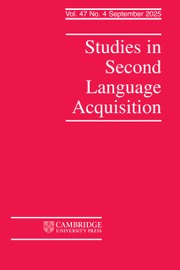Article contents
NEGATIVE ITEMS AND NEGATION STRATEGIES IN NONNATIVE ITALIAN
Published online by Cambridge University Press: 10 February 2001
Abstract
Acquisition of negation in Italian as a second language (L2) is investigated on the basis ofthe longitudinal data of five learners with different first languages (L1s) in the framework of afunctional approach focusing on the semantic and pragmatic principles governing theorganization of learner varieties and the process of their complexification. Negation develops in acumulative process in four successive stages. New constructions entering into interlanguage (IL)at each stage effect reduction in frequency of use of previous constructions that specialize forspecial functions, such as constituent negation. The acquisition process provides insight intosome of the mechanisms involved in the processing and filtering of grammatical elements fromthe input and into strategies employed by the learners to integrate the expression of the scope ofnegation into the syntactic organization of their variety. The results contribute to a betterunderstanding of the acquisition processes of negation in L2s, allowing the comparison of thedevelopment of a relatively straightforward target with an invariable preverbal particle, Italian,with the better investigated development of the complex patterns of English and German.
Information
- Type
- Research Article
- Information
- Copyright
- © 2000 Cambridge University Press
- 15
- Cited by

